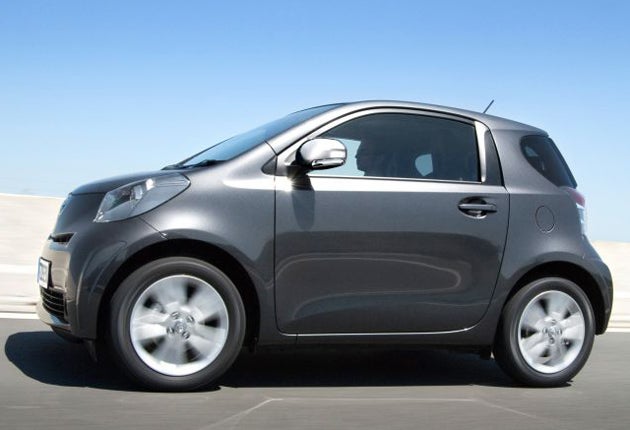Toyota iQ
Who you calling small, then? The iQ is back and beefy

Your support helps us to tell the story
From reproductive rights to climate change to Big Tech, The Independent is on the ground when the story is developing. Whether it's investigating the financials of Elon Musk's pro-Trump PAC or producing our latest documentary, 'The A Word', which shines a light on the American women fighting for reproductive rights, we know how important it is to parse out the facts from the messaging.
At such a critical moment in US history, we need reporters on the ground. Your donation allows us to keep sending journalists to speak to both sides of the story.
The Independent is trusted by Americans across the entire political spectrum. And unlike many other quality news outlets, we choose not to lock Americans out of our reporting and analysis with paywalls. We believe quality journalism should be available to everyone, paid for by those who can afford it.
Your support makes all the difference.Intriguing little car, the Toyota iQ. Every drive in one is an event. Other drivers look on in envy as you squeeze its tiny length into a parking space, helped by the tightest of turning circles. Frissons of annoyance on the open road, as they spy what they assume to be an economy car about to get in their way, only to have the iQ thrum away into the distance.
Sometimes they assume an iQ is narrow as well as short, but it is not. Unexpectedly tight squeezes occur in country lanes. This is the iQ's major failing: it's too broad. It was designed to fit two adults between its rear wheel arches, but if there is width enough for two there certainly isn't the length. If I had designed the iQ, I would have made it narrower, with room for just one adult in the back, or two small children.
Anything else I would change? The gearing. Its tiny 1.0-litre, three-cylinder engine makes a lovely, deep sound and tries willingly to do its job, but it is stifled by ludicrously long-legged gear ratios. Blame the way the fuel-economy and CO2 tests are framed, tests which mandate not just a set sequence of speeds and unrealistically gentle accelerations but also what gear a car must be in for each part of the test. So each gear is made "long", because the longer-legged the gearing, the lower the fuel consumption provided the engine can still generate the meagre acceleration required.
So when you want to accelerate at normal rates and not clog up the road, you have to work the engine hard and hang on to the lower gears for longer. This is not great for fuel economy, and it means that the test-measured average of 67.3mpg and 99g/km CO2 will never be replicated in the real world.
What the iQ needs, then, is either a more sensible set of gear ratios or a more muscular engine. And given that one of the existing iQ's big selling points is its official CO2 rating, for which it must retain those ratios, a bigger engine is the obvious solution. And now, for £11,495, you can have one. It uses the four-cylinder, 1.33-litre engine, so you lose the intriguing soundtrack but gain nearly 50 per cent more power, up from 68bhp to 99bhp. Top speed goes up from 93mph to 106mph, acceleration from a standstill to 62mph takes a claimed 13.4 seconds instead of 14.1, yet CO2 emissions don't suffer much as they are still rated at just 113g/km. That means £30 road tax instead of none, but it's hardly a disaster.
This bigger-engined iQ comes only in a high-specification iQ3 trim level which includes larger, 16in wheels and a new metallic grey paint colour. There's the option of an automatic with a continuously-variable transmission, which lets the engine speed roam free to the benefit of pace if not economy; its claimed 0-62mph time is slightly better. There are no "virtual ratios" to select manually, unlike with some CVTs, but you can lock it in a more sporting mode which encourages the engine to rev more freely.
Part of the manual's economy and CO2 advantage comes from its standard stop-start system, one able to work very quickly because the starter always stays engaged with its engine ring gear. This ring gear, instead of being permanently attached to the engine's flywheel, is coupled to it when needed via a clutch. Restart, by depressing the clutch pedal, takes less than half a second, and the engine elects not to stop at a standstill if sensors detect the cabin hasn't reached a selected heat setting or is misted-up.
Aston Martin has announced plans to sell an ultra-plush iQ, renamed Aston Martin Cygnet and marketed as the must-have accessory for urban Aston owners. But, to me, an iQ has its own strong personality which should not be made fun of with ludicrous luxury-car grillework.
Just before I drove the 1.33, I saw a video showing how the iQ earnt its five-star EuroNCAP crash-test rating. It was smitten hard on the side by a big, cruel Lexus and tossed uncaringly (but safely, for the occupants) aside. And still its little face beamed. I fully expected it to burst into tears but it smiled stoically on. The tear was in my eye instead.
Join our commenting forum
Join thought-provoking conversations, follow other Independent readers and see their replies
Comments